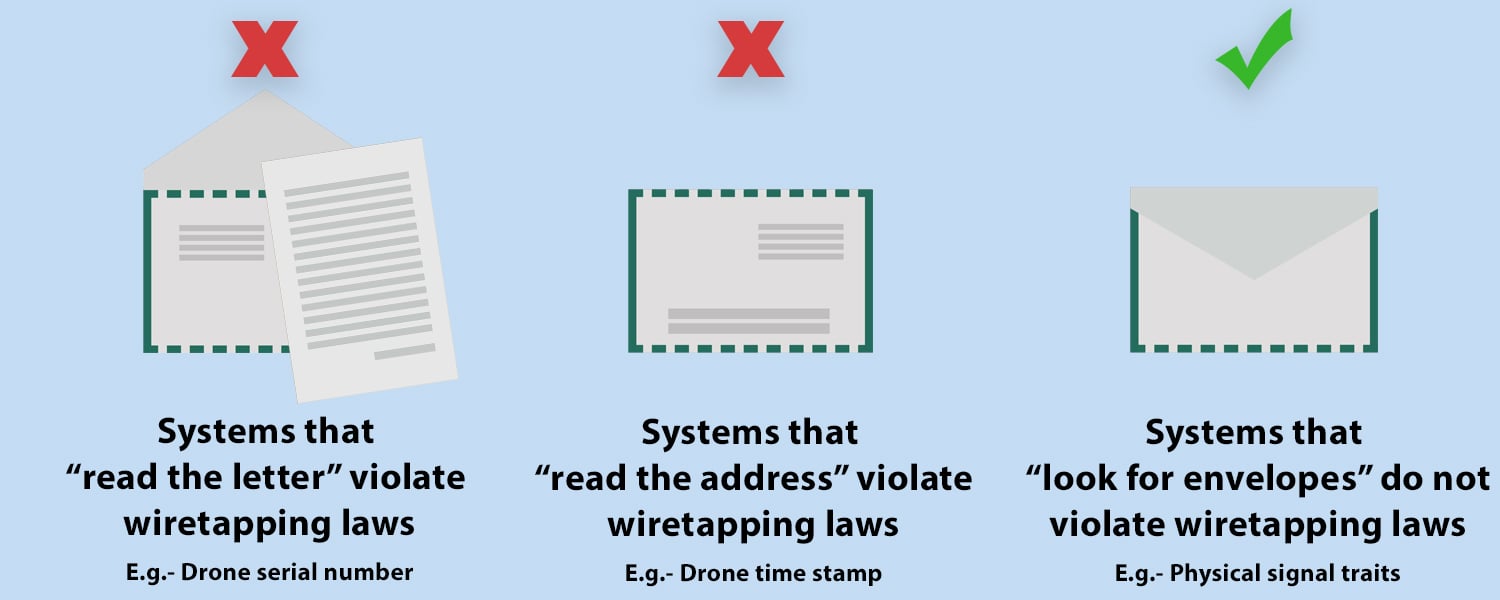As drone manufacturers continue to produce faster drones with heavier payloads, drone-borne contraband deliveries will only increase in volume, and the risks to corrections facilities can’t be overstated.
Delivery of cell phones and drugs have far reaching effects on inmate and staff safety, but many facilities worry about the immediate threats related to delivery of weapon(s) or tools. Before deciding how to respond to the threat, carefully consider the following laws and regulations.
Laws That The Bad Guys Ignore
If you are a Federal Bureau of Prisons (FBOP) facility – The Federal Aviation Administration (FAA) has banned drone flights up to 400 feet at 109 out of 122 FBOP facilities.
If you are not an FBOP facility – Currently nineteen (19) states have outlawed drone flights over prisons. Some states’ laws are more specific than others about drone-borne contraband. However, these laws will not deter clueless/careless hobbyists or contraband pilots.
Laws That Restrict What The Good Guys Can Do
In August 2020, the FAA, Department of Justice (DOJ), Federal Communications Commission (FCC), and Department of Homeland Security (DHS) issued a joint advisory guidance document to help non-federal public and private entities understand the laws and regulations related to the use of technology to detect and mitigate drones.
In the report they identify the four Federal agencies who can operate mitigation systems: Department of Defense (DOD), Department of Energy (DOE), Department of Justice (DOJ) and the Department of Homeland Security (DHS). There are a few reasons for such strict mitigation regulation:
-
-
- The FAA considers drones as aircraft and therefore their flight cannot be interfered with.
- A drone weighing 5-55 pounds falling from hundreds of feet in the air can injure or kill someone and cause property damage.
-
Even if laws change to allow mitigation, any drone flight interference resulting in injury/damage becomes the legal responsibility of your facility.
What Drone Detection Technology Can I Use?
Given drone mitigation restrictions, corrections facilities depend on drone detection technology to alert them when a drone and/or operator is near their facility. Of the four detection technologies…
-
-
- Radar
- Camera/infrared
- Acoustic
- Radio Frequency (RF)
-
…RF is the only detection method that can detect/locate the drone and its pilot (controller).
The drone’s location may facilitate confiscation of contraband before it gets into the wrong hands, but the additional information of the pilot’s location allows you to stop the flight, prevent future delivery attempts by that pilot, and deter other nefarious actors.
The DOJ and FCC consider the signal between the drone and its controller to be private, much like a telephone conversation. RF drone detection systems that extract information like a drone serial number disregard Federal surveillance laws that protect these electronic communications.
It may be satisfying to get that information in the short term, but if it won’t hold up in court there’s no value. And you could expose yourself to potential fines and criminal penalties.
In fact, the 2020 FAA, DOJ, FCC, and DHS joint advisory states that many RF detection systems implicate Federal surveillance laws, and Federal users of such technology must obtain a waiver to operate.
The DOJ Office of Community Oriented Policing Systems (COPS) also issued a report in 2020 in which they explain why most RF drone detection technologies present legal complications. Like the joint advisory, they advise agencies and companies must conduct a detailed legal review before purchase of a drone detection system.
In the COPS report, they use the analogy of an envelope and ask you to imagine RF signals as a letter.

RF-based drone detection systems that “read the letter” are in clear violation of the Federal surveillance laws referenced in the joint advisory and COPS report on drone detection: The Wiretap Act and Pen/Trap Statute. These are systems that extract information from the drone signal like GPS coordinates, serial number, manufacturer make/model, and more.
Some RF-based drone detection vendors may claim their technology is legal because it is purely “passive” and does not “open the envelope” to obtain the “content” of communications.
That may be misleading though, because the federal Pen/Trap Act prohibits the interception of noncontent information associated with electronic communications.
Non-content information would be information on the outside of the envelope: the addresses of the sender and recipient. For drones this could be the time stamp.
The COPS report goes on to warn that violations of the Pen/Trap Act are serious and may give rise to criminal and civil liability.
If you extend the analogy to include drone detection systems that can be legally operated because they do not intercept drone signals: Systems that do not require authorization simply look for the presence of an RF signal with drone-like characteristics which is the equivalent of looking for the mere presence of an envelope.
This can be achieved by a technique called “spectrum sensing.” It detects physical energy generated by frequency-hopping drones/controllers, much like a geiger-counter detects the presence of radioactive material, without intercepting electronic communications that are not publicly available.
Other Resources
Federal drone laws:
-
-
- 18 U.S. Code § 1752 - Restricted building or grounds
- Unsafe operation of unmanned aircraft (if your facility is near an airport)
- FAA State and Local Regulation of Unmanned Aircraft Systems (UAS) Fact Sheet (includes contact information for the FAA’s Office of Chief Counsel)
Other articles in this series:
-